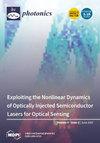Polarization Influence on Er3+-Doped Multi-Wavelength Brillouin Fiber Laser Based on Fiber Loop Mirror
IF 2.1
4区 物理与天体物理
Q2 OPTICS
引用次数: 0
Abstract
Polarization influences on the performance of multi-wavelength Brillouin Er3+-doped fiber laser are investigated by adjusting the polarization controller (PC) in the fiber loop mirror (FLM), where the linear laser cavity is composed of a fiber-tailed mirror and an FLM, and the stimulated Brillouin scattering (SBS) and the Er3+-doped fiber amplification (EDFA) simultaneously serve as the cavity gain. We realized 1–7 Brillouin laser lines by increasing the 980 nm pump power. For the first-order Brillouin laser, the signal–noise ratio (SNR) and optical intensity present a sinusoidal envelope; the conversion efficiency changes significantly from 0.56465 dBm/mw to 0.44975 dBm/mw by adjusting the ring’s angle in the PC; the first-order SBS thresholds are 20.4 mw, 36.1 mw and 28.5 mw at different angles θ2 = 36°, 276° and 300°, respectively; flatness between the two Brillouin lasers change obviously from 2.863 dB to 41.801 dB with different ring angles; the second-order Brillouin laser is suppressed and disappears finally at Δθ2 = −64° to −84° and 106°~136° angle variation. For the fifth-order Brillouin laser, the highest-order Brillouin laser line is seriously suppressed until it disappears at some angle variations similarly. The powers and wavelength stabilities for one-, three- and seven-wavelength Brillouin fiber lasers were measured in 1 h, and the obtained Er3+-doped multi-wavelength Brillouin fiber laser (MWBFL) worked stably during that time, but the stabilities become worse with higher SBS orders.偏振对基于光纤环镜的掺 Er3+ 多波长布里渊光纤激光器的影响
通过调节光纤环镜(FLM)中的偏振控制器(PC),研究了偏振对多波长布里渊掺Er3+光纤激光器性能的影响。线性激光腔由光纤尾镜和FLM组成,受激布里渊散射(SBS)和掺Er3+光纤放大(EDFA)同时作为腔增益。通过增加 980 nm 的泵浦功率,我们实现了 1-7 条布里渊激光线。对于一阶布里渊激光器,信噪比(SNR)和光强呈现正弦包络;通过调整 PC 中的环角度,转换效率从 0.56465 dBm/mw 显著变化到 0.44975 dBm/mw;一阶 SBS 门限分别为 20.4 mw、36.1 mw 和 28.5 mw;两个布里渊激光器之间的平坦度随着环角度的不同从 2.863 dB 明显变化到 41.801 dB;二阶布里渊激光器在 Δθ2 = -64° 到 -84° 以及 106°~136° 角度变化时被抑制并最终消失。对于五阶布里渊激光器,最高阶布里渊激光线同样在某些角度变化时被严重抑制直至消失。在 1 小时内测量了一阶、三阶和七阶布里渊光纤激光器的功率和波长稳定性,得到的 Er3+ 掺杂多波长布里渊光纤激光器(MWBFL)在这段时间内工作稳定,但稳定性随着 SBS 阶数的提高而变差。
本文章由计算机程序翻译,如有差异,请以英文原文为准。
求助全文
约1分钟内获得全文
求助全文
来源期刊

Photonics
Physics and Astronomy-Instrumentation
CiteScore
2.60
自引率
20.80%
发文量
817
审稿时长
8 weeks
期刊介绍:
Photonics (ISSN 2304-6732) aims at a fast turn around time for peer-reviewing manuscripts and producing accepted articles. The online-only and open access nature of the journal will allow for a speedy and wide circulation of your research as well as review articles. We aim at establishing Photonics as a leading venue for publishing high impact fundamental research but also applications of optics and photonics. The journal particularly welcomes both theoretical (simulation) and experimental research. Our aim is to encourage scientists to publish their experimental and theoretical results in as much detail as possible. There is no restriction on the length of the papers. The full experimental details must be provided so that the results can be reproduced. Electronic files and software regarding the full details of the calculation and experimental procedure, if unable to be published in a normal way, can be deposited as supplementary material.
 求助内容:
求助内容: 应助结果提醒方式:
应助结果提醒方式:


